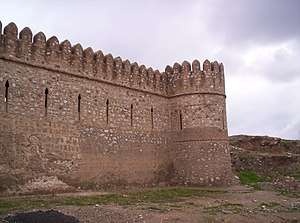Kirkuk Citadel
The Kirkuk Citadel (Kurdish: قەڵای کەرکووک, Arabic: قَلْعَة كَرْكُوْك, romanized: Qalʿat Karkūk, Turkish: Kerkük Kalesi, Syriac: ܩܠܥܐ ܕܟܪܟܘܟ, romanized: Qala d Kerkouk) is located in the centre of the city of Kirkuk in Iraq, and is considered to be the oldest part of the city. The citadel stands on an artificial mound 130 feet high located on a plateau across the Khasa River.
| Kirkuk citadel | |
|---|---|
| Kirkuk, Iraq | |
 View of the Kirkuk citadel | |
 Kirkuk citadel Location in Iraq | |
| Coordinates | 35°28′11″N 44°23′45″E |
| Site information | |
| Open to the public | Yes |
| Condition | Partially ruined |
History

The mound, or tell is believed to have been built by King Ashurnasirpal II between 884 and 858 BCE as a military defence line of Arrapha. By 4000 years ago, the Akadian/Assyrian called it the Castle of Shilwases because the ruler was the Hurrian King Shilwa Teshub.
Later King Seleucus I Nicator[1] built a strong rampart with 72 towers around the 72 streets and the two entries to the citadel. A jewel of the citadel is the so-called "Red Church", with traces of mosaics dating to the period before the Islamic conquest of Iraq in the 7th century. It is believed that Timur visited the citadel in 1393 during his military expedition. The modern walls go back to the Ottoman period.
In the 1990s, Saddam Hussein, the former Iraqi president, announced a campaign to beautify the walled citadel. A large number of historical and religious sites still exist there, including a monument believed to be the Tomb of Daniel.[2]
See also
References
- Clifford Edmund Bosworth. The Encyclopaedia of Islam. p. 144.
- "كركوك في العصور القديمة", ئاراس (in Arabic)

.jpg)
